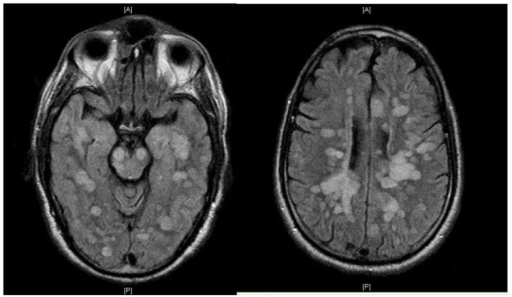Acute Disseminated Encephalomyelitis

A demyelinating disorder of the central nervous system.
Epidemiology
The incidence rate has been estimated at 1 in 125,000-250,000 per year.
Clinical description
Children younger than 10 years are predominantly affected. A seasonal winter and spring peaks have been registered. The disease usually develops after acute viral or bacterial infection or vaccination, with a sudden onset of irritability and lethargy after a prodromal period of 1-4 weeks. Major symptoms include fever, headache, drowsiness, changes in mental status, seizures and coma. Weakness, vomiting, weight loss, stiff neck, ataxia, bilateral optic neuritis and delirium are common. Peripheral nervous system involvement (paralysis of a single limb or hemiplegia) occurs in 5-45% of cases, according to literature data. Although initially the symptoms of ADEM may be mild, they worsen rapidly within several hours to four days. Pathologically, ADEM is characterized by bilateral large and confluent lesions in cerebral and cerebellar white matter; basal ganglia and gray matter may also be involved. ADEM lesions in the spinal cord are continuous and extending to multiple levels. Some authors consider the disease as a variant or borderline form of multiple sclerosis (MS) (see this term).
Etiology
ADEM is considered as an immune-mediated disorder of the central nervous system. It can arise spontaneously but in most cases the disease is triggered by infectious disease or vaccinations. Links between the Pasteur rabies vaccine and ADEM have been documented. Immunizations less frequently associated with ADEM include pertussis, measles, Japanese B virus, tetanus, influenza.
Diagnostic methods
Diagnosis is based on the clinical history and magnetic resonance imaging, which is the diagnostic modality of choice.
Differential diagnosis
MS is the main differential diagnosis. The differentiation between ADEM and a first episode of MS can be very difficult but has important prognostic and treatment implications. Differential diagnosis also includes infectious encephalitis, Guillain-Barré syndrome, glioblastoma multiforme, Schilder's disease (see these terms), psychotic disorders with acute onset, toxic/metabolic encephalopathy, vasculitis, nonvasculitic autoimmune encephalopathy, meningitis, metastatic tumor.
Management and treatment
Currently, immunosuppression with corticosteroids for the acute events is the mainstay of treatment. In patients refractory to steroid therapy, plasmapheresis or intravenous immunoglobulin therapy can be used. Symptomatic and supportive treatments are recommended.
Prognosis
ADEM is typically a monophasic (single episode) disease with generally favorable outcome. Average time to recover is one to six months. Relapses may occur in 5-25% of cases, generally 6-18 months after the onset. Fulminant presentation with cerebral edema requiring critical intensive care is rare.